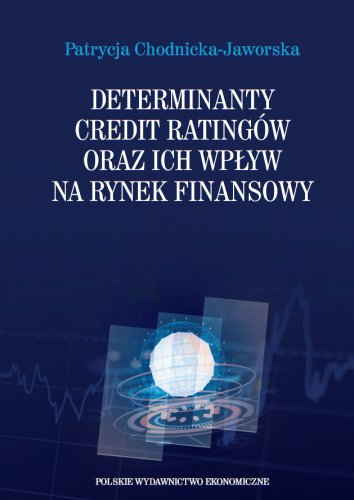Determinanty credit ratingów oraz ich wpływ na rynek finansowy
Publication date: 2019
Place publication: Warszawa
Publication: I
Binding: paperback
Format: B5
The book is an effect of many years of research carried out by the Author in the Faculty of Management of the University of Warsaw. The objective of the work is to examine four key areas within the segment of banks’ credit ratings which are as follows:
• determinants of credit ratings applied by banks and countries, including interrelations occurring among them,
• reactions of financial instruments to changes in credit ratings of banks,
• an influence of strategies undertaken by rating agencies upon final credit ratings applied by banks,
• procyclical nature of credit ratings, taking into account a level of individual countries’ economic development, political divisions, the size of rating agencies or the type of credit ratings.
Intellectual capital and compliance in the processes of constituting the excellence of organizations’ social responsibility systems ID: 450182506
The principal objective of the work is conceive, understand, describe and explain the specificity and importance of intellectual capital and an integrating role of the instrument of compliance in the process of achieving the excellence of social responsibility of an enterprise. All this is seen in perspective of the importance of the role performed in the process by leaders – persons distinguished by particular moral competences, capable of setting rational direction to behaviors of organizations and therefore control their development as socially responsible entities.
Chapter one of the book identifies trends and tendencies that determine corporate management aiming at the achievement, by enterprises, of the vision of socially responsible organizations. The point of reference assumed this respect were ascertainments concerning ethical and social pre-requisites for management of contemporary organizations. Chapter two is mainly an attempt to present the issues concerning the problems of intellectual capital in terms of its role in constituting socially responsible organization. In chapter three the Author’s focus is upon a mechanism of compliance seen from the point of view of its integrating functions in corporate social responsibility systems. Considerations undertaken in chapter four serve as an introduction to an empirical part of the book. Here the Author develops a method of her original research, together with a procedure of the research process. In chapter five the findings of empirical research carried out by the Author are presented. It also precisely describes the research method applied in a case study and in a quantitative study. Together, all these chapters form the basis for development, included in the final chapter, of the concept of the Model of Achieving an Excellence of Social Responsibility Systems. Description of the Author’s original model is here preceded by presentation of the principal theoretical assumptions that provide the basis for the model. The same chapter also presents recommendations resulting from the model developed. The ending part includes conclusions stemming from the theoretical and empirical considerations in the area of the subject in question, as well as premises for any future research concerning the development of processes of achieving excellence in social responsibility.
Spis treści
Wstęp
1. Charakterystyka credit ratingu i agencji ratingowych
1.1. Istota i definicja credit ratingu
1.1.1. Definicje credit ratingu
1.1.2. Klasyfikacja credit ratingu
1.1.3. Oceny ratingowe z punktu widzenia poziomu ryzyka
1.1.4. Nastawienie krótko- i długoterminowe
1.2. Agencje ratingowe i specyfika ich działalności
1.2.1. Definicja agencji ratingowej
1.2.2. Agencje ratingowe w strukturze systemu finansowego
1.2.3. Proces nadawania ocen ratingowych
1.2.4. Charakterystyka wybranych agencji ratingowych
1.2.5. Analiza konkurencji w branży agencji ratingowych
1.2.6. Bariery wejścia agencji ratingowych
1.3. Wnioski
2. Credit rating i agencje ratingowe w przepisach prawnych
2.1. Regulacje dotyczące agencji ratingowych i credit ratingów w Unii Europejskiej
2.2. Kierunki zmian legislacyjnych podjętych w Unii Europejskiej i jej krajach członkowskich
2.3. Modele alternatywne i zagrożenia z nich płynące
2.4. Ocena zdolności kredytowej w świetle przepisów Unii Europejskiej
2.5. Wnioski
3. Polityka kosztowa agencji ratingowych
3.1. Modele systemów opłat
3.1.1. Model emitent płaci
3.1.2. Model inwestor płaci
3.1.3. Model rząd płaci
3.1.4. Modele hybrydowe
3.2. Problem płatności za informację w teorii ekonomii
3.3. Modele alternatywne finansowania credit ratingów w świetle teorii ekonomii
3.3.1. Model dyscypliny agencji ratingowej Bongaertsa
3.3.2. Model alternatywny Chodnickiej
3.4. Wnioski
4. Teoria podejmowania decyzji agencji ratingowych i ich wpływ na model biznesowy
4.1. Model konfliktu interesów Sangiorgiego i Spatta
4.2. Model alternatywny Deba i Murphy’ego
4.3. Model reputacji Mathisa, McAndrewsa i Rocheta
4.3.1. Właściwości niezgodnej z prawdą równowagi
4.3.2. Niedoskonałe monitorowanie
4.4. Model równowagi Holdena, Natvika i Nigera
4.4.1. Strategia gry w odosobnieniu
4.4.2. Mechanizmy ratingów
4.4.3. Równowaga
4.4.4. Zachęty agencji i skutki ratingów
4.5. Model alternatywny Bongaertsa
4.5.1. Agencje opłacane przez inwestorów
4.5.2. Równowaga Frankena
4.5.3. Zakaz funkcjonowania agencji opłacanych przez emitenta
4.5.4. Prywatne korzyści i koszty
4.6. Model utraty reputacji Jeona i Lova
4.6.1. Podstawowy model budowania reputacji
4.6.2. Model nieskończonego horyzontu
4.6.3. Ograniczenia wejścia i wyjścia
4.6.4. Polityka oceny i wdrażanie projektów
4.6.5. Ewolucja reputacji
4.6.6. Społecznie optymalne eksperymenty
4.6.7. Konkurencja
4.6.8. Wielokrotne oceny
4.6.9. Opłaty warunkowe
4.6.10. Regulowany monopol warunkowy
4.7. Model efektów zwrotnych
4.7.1. Model bez agencji ratingowej
4.7.2. Równowaga przy występowaniu agencji ratingowej
4.8. Siły nacisku na agencje ratingowe ze strony inwestorów i emitentów
4.9. Wnioski
5. Determinanty oceny ratingowej
5.1. Podejście „twarde” i „miękkie” w ocenie ryzyka
5.2. Credit rating kraju — czynniki ryzyka
5.2.1. Moody’s Investor Service
5.2.2. Standard & Poor’s Global Ratings
5.3. Credit rating banku
5.3.1. Moody’s Investor Service
5.3.2. Standard & Poor’s Global Ratings
5.4. Wnioski
6. Analiza czynników ryzyka wpływających na ocenę ratingową
6.1. Analiza głównych czynników ilościowych oceny ryzyka
6.1.1. Analiza czynników wpływających na credit rating krajów
6.1.2. Analiza czynników wpływających na credit rating banków
6.2. Analiza głównych czynników jakościowych oceny ryzyka
6.2.1. Główny problem agenta
6.2.2. Hipoteza dotycząca redystrybucji zasobów
6.3. Inflacja credit ratingów
6.4. Credit rating a segment działalności — wyniki badań własnych
6.5. Credit rating a forma własności — wyniki badań własnych
6.6. Credit rating a wielkość banku — wyniki badań własnych
6.7. Credit rating emitenta a inwestora
6.8. Credit rating zamówiony i niezamówiony oraz współzależność credit ratingów
6.8.1. Przegląd literatury
6.8.2. Wyniki badań własnych
6.9. Badanie procykliczności ratingów kredytowych
6.9.1. Przegląd literatury
6.9.2. Wyniki badań własnych
6.10. Analiza wpływu ryzyka kraju na zmiany not ratingowych
6.11. Wnioski
7. Credit rating w teorii rynku kapitałowego
7.1. Credit rating w klasycznej teorii rynku kapitałowego
7.1.1. Teoria użyteczności a credit rating
7.1.2. Credit rating a teoria portfelowa
7.1.3. Model wyceny dóbr kapitałowych
7.1.4. Teoria efektywności rynku kapitałowego
7.2. Finanse behawioralne a credit rating
7.2.1. Psychologiczne aspekty podejmowania decyzji a credit rating
7.2.2. Teoria perspektyw
7.2.3. Modele zachowań stadnych a credit rating
7.2.4. Prognozy analityków a credit rating
7.2.5. Ograniczenia arbitrażu
7.2.6. Premia za ryzyko cen akcji
7.2.7. Efekt dnia tygodnia w obliczu zmiany credit ratingu
7.3. Behawioralne modele rynku kapitałowego a credit rating
7.3.1. Model sentymentu inwestora
7.3.2. Model Daniela, Hirshleifera i Subrahmanyama
7.3.3. Model Honga i Steina
7.3.4. Model subiektywnej wyceny aktywów
7.3.5. Modele finansów behawioralnych — analiza fundamentalna a niefundamentalna
7.3.6. Modele finansów behawioralnych — dywersyfikacja informacyjna
7.3.7. Model Famy i MacBetha
7.3.8. Modele rynkowe
7.4. Wnioski
8. Wpływ zmian credit ratingu na rynek finansowy
8.1. Credit rating a kurs walutowy
8.2. Credit rating a rynek międzybankowy
8.3. Credit rating a rynek obligacji
8.4. Credit rating a credit derivate swaps
8.5. Credit rating a kurs akcji
8.5.1. Wpływ zmian credit ratingów na ceny akcji spółek spoza sektora finansowego
8.5.2. Wpływ zmian nastawienia credit ratingów na ceny akcji spółek spoza sektora finansowego
8.5.3. Wpływ zmian nastawienia oraz credit ratingów na ceny akcji spółek z sektora bankowego
8.6. Wnioski
Zakończenie
Załączniki
Bibliografa
| Odbiór osobisty | 0 € |
| Kurier Inpost | 4 € |
| Kurier FedEX | 4 € |
| Inpost Paczkomaty | 4 € |
| Free delivery in Reader's Club | from 47 € |


